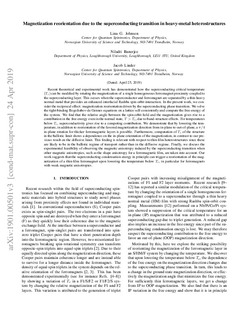| dc.contributor.author | Johnsen, Lina G. | |
| dc.contributor.author | Banerjee, Niladri | |
| dc.contributor.author | Linder, Jacob | |
| dc.date.accessioned | 2020-01-13T12:42:32Z | |
| dc.date.available | 2020-01-13T12:42:32Z | |
| dc.date.created | 2019-07-25T11:55:16Z | |
| dc.date.issued | 2019 | |
| dc.identifier.citation | Physical review B (PRB). 2019, 99 (13), 134516-1-134516-11. | nb_NO |
| dc.identifier.issn | 2469-9950 | |
| dc.identifier.uri | http://hdl.handle.net/11250/2635985 | |
| dc.description.abstract | Recent theoretical and experimental work has demonstrated how the superconducting critical temperature (Tc) can be modified by rotating the magnetization of a single homogeneous ferromagnet proximity-coupled to the superconducting layer. This occurs when the superconductor and ferromagnet are separated by a thin heavy normal metal that provides an enhanced interfacial Rashba spin-orbit interaction. In the present work, we consider the reciprocal effect: magnetization reorientation driven by the superconducting phase transition. We solve the tight-binding Bogoliubov-de Gennes equations on a lattice self-consistently and compute the free energy of the system. We find that the relative angle between the spin-orbit field and the magnetization gives rise to a contribution in the free energy even in the normal state, T > Tc, due to band-structure effects. For temperatures below Tc, superconductivity gives rise to a competing contribution. We demonstrate that by lowering the temperature, in addition to reorientation of the favored magnetization direction from in-plane to out-of-plane, a π/4 in-plane rotation for thicker ferromagnetic layers is possible. Furthermore, computation of Tc of the structure in the ballistic limit shows a dependence on the in-plane orientation of the magnetization, in contrast to our previous result on the diffusive limit. This finding is relevant with respect to thin-film heterostructures since these are likely to be in the ballistic regime of transport rather than in the diffusive regime. Finally, we discuss the experimental feasibility of observing the magnetic anisotropy induced by the superconducting transition when other magnetic anisotropies, such as the shape anisotropy for a ferromagnetic film, are taken into account. Our work suggests that the superconducting condensation energy in principle can trigger a reorientation of the magnetization of a thin-film ferromagnet upon lowering the temperature below Tc, in particular for ferromagnets with weak magnetic anisotropies | nb_NO |
| dc.language.iso | eng | nb_NO |
| dc.publisher | American Physical Society | nb_NO |
| dc.title | Magnetization reorientation due to the superconducting transition in heavy-metal heterostructures | nb_NO |
| dc.type | Journal article | nb_NO |
| dc.type | Peer reviewed | nb_NO |
| dc.description.version | acceptedVersion | nb_NO |
| dc.source.pagenumber | 134516-1-134516-11 | nb_NO |
| dc.source.volume | 99 | nb_NO |
| dc.source.journal | Physical review B (PRB) | nb_NO |
| dc.source.issue | 13 | nb_NO |
| dc.identifier.doi | 10.1103/PhysRevB.99.134516 | |
| dc.identifier.cristin | 1712675 | |
| dc.description.localcode | © American Physical Society 2019. This is the authors accepted and refereed manuscript to the article. | nb_NO |
| cristin.unitcode | 194,66,20,0 | |
| cristin.unitname | Institutt for fysikk | |
| cristin.ispublished | true | |
| cristin.fulltext | postprint | |
| cristin.qualitycode | 2 | |
